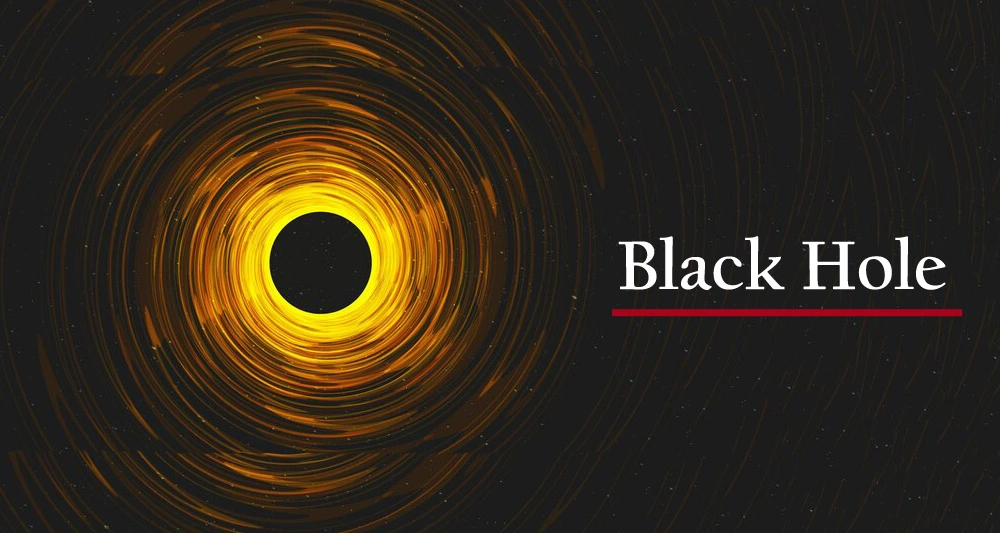What is black hole
A black hole is a region of space where the gravitational pull is so strong that nothing, including light, can escape its boundary known as the event horizon.
It is formed when a massive star collapses under the force of its own gravity, causing its matter to be squeezed into a tiny space with extremely high density and gravity. The gravitational force in a black hole is so intense that it warps the fabric of space and time, creating a singularity at the center, which is a point of infinite density and gravity.
Black holes come in different sizes and types, ranging from stellar black holes that are a few times more massive than the Sun to supermassive black holes that are billions of times more massive than the Sun and located at the center of galaxies. Black holes have captivated the imagination of scientists and the public alike, as they challenge our understanding of the laws of physics and the nature of the universe.
Why do black holes exist
Black holes exist as a consequence of the laws of physics, specifically Einstein’s theory of General Relativity. When a massive star runs out of fuel and is no longer able to support itself against gravity, it will undergo a catastrophic collapse, which can result in the formation of a black hole.
According to General Relativity, massive objects cause a distortion in the fabric of spacetime, which we experience as gravity. As a star collapses, it becomes increasingly dense and its gravity becomes stronger, until it reaches a point where not even light can escape its gravitational pull. This point is known as the event horizon, and the object that remains within it is called a black hole.
The existence of black holes has been confirmed through observations of their effects on nearby objects, such as stars and gas clouds. While they are still somewhat mysterious and elusive, the study of black holes is an active area of research in astrophysics and has led to many fascinating discoveries about the nature of the universe.
How is a black hole formed
A black hole is formed from the remnants of a massive star that has exhausted all of its nuclear fuel and has undergone a supernova explosion. When the core of such a star collapses under its own gravity, it can become so dense that nothing can escape its gravitational pull, not even light. This creates what is known as a singularity at the center of the collapsed star, which is surrounded by an event horizon, the boundary beyond which no information or matter can escape.
The formation of a black hole requires a minimum mass, known as the Chandrasekhar limit, which is approximately 1.4 times the mass of our sun. If the core of the collapsing star is less massive than this limit, it will form a neutron star, which is another highly dense object.
Black holes can also be formed through the merger of two or more black holes, which is thought to occur when galaxies collide and their central supermassive black holes merge. This can result in the formation of even more massive black holes.
History of black hole
The concept of black holes as we understand them today was first proposed by the British physicist and mathematician John Michell in 1783. He suggested that if a massive object were to have enough gravitational pull, it could trap even light within its surface, making it invisible to the outside world.
However, it wasn’t until the early 20th century that the idea of black holes began to take shape in its current form. In 1915, Albert Einstein’s theory of general relativity was published, which described gravity as the curvature of spacetime. This theory predicted the existence of black holes, although Einstein himself was initially skeptical of the concept.
In 1931, Indian astrophysicist Subrahmanyan Chandrasekhar showed that there is a limit to how massive a star can be before it collapses into a black hole. This limit is now known as the Chandrasekhar limit, and it depends on the star’s composition and temperature.
In the 1960s, several researchers independently discovered the concept of a singularity, a point of infinite density and gravity at the center of a black hole. In 1967, physicist John Wheeler coined the term “black hole” to describe these mysterious objects.
Since then, astronomers have discovered many black holes in our universe, ranging from a few times the mass of our Sun to billions of solar masses. The study of black holes has revolutionized our understanding of the universe, as these objects can be used to test the limits of our current theories of physics and the nature of spacetime itself.
What is inside a black hole
The interior of a black hole is often referred to as the “singularity,” which is a point of infinite density and infinite gravity. According to our current understanding of physics, the laws of physics as we know them break down inside a black hole, so it’s difficult to say what exactly is inside.
The event horizon, the boundary surrounding a black hole from which nothing can escape once it crosses that threshold, is a one-way membrane that prevents any information or matter from escaping. So, any matter that enters the event horizon is thought to be crushed and compressed by the immense gravitational forces and become part of the singularity.
However, this is still just a theoretical concept, as we cannot directly observe what is happening inside a black hole. Our understanding of black holes comes from the way they affect their surroundings and the behavior of light around them, but the interior remains a mystery.
Types of black hole
There are three main types of black holes, classified according to their mass and properties:
- Stellar black holes: These are the most common type of black hole, formed when a massive star runs out of fuel and collapses under its own gravity, resulting in a singularity. Stellar black holes have a mass ranging from a few times that of the Sun up to around 100 times that of the Sun.
- Intermediate black holes: These are less common than stellar black holes, and have a mass ranging from around 100 to 100,000 times that of the Sun. The origin of intermediate black holes is still not fully understood, but they may form through the merging of smaller black holes, or from the collapse of a massive gas cloud.
- Supermassive black holes: These are the largest and most massive type of black hole, with a mass ranging from millions to billions of times that of the Sun. Supermassive black holes are found at the centers of most galaxies, including our own Milky Way, and are thought to have formed through the accretion of matter and mergers with other black holes over billions of years.
NASA
NASA has made several important discoveries related to black holes over the years. Here are a few notable ones:
- Cygnus X-1: In 1971, NASA’s Uhuru satellite discovered the first X-ray source believed to be a black hole, called Cygnus X-1. Later observations confirmed that the system consists of a massive star in orbit around an unseen object with a mass about 14 times that of the sun.
- Gravitational waves from black hole mergers: In 2015, NASA’s Laser Interferometer Gravitational-Wave Observatory (LIGO) detected gravitational waves for the first time. These ripples in space-time were produced by the merger of two black holes about 1.3 billion light-years away.
- Active Galactic Nuclei: NASA’s Chandra X-ray Observatory has observed supermassive black holes at the centers of distant galaxies, which are surrounded by accretion disks of gas and dust that emit X-rays. These objects, known as Active Galactic Nuclei (AGN), are among the most energetic phenomena in the universe.
- Sagittarius A*: NASA’s orbiting Chandra X-ray Observatory and the ground-based Event Horizon Telescope have been used to study Sagittarius A*, the supermassive black hole at the center of our Milky Way galaxy. These observations have provided insights into the behavior of matter in the extreme gravitational environment near a black hole.
- Black hole “coronas”: In 2020, NASA’s Neutron star Interior Composition Explorer (NICER) discovered that black holes have “coronas” – hot, energetic regions above and below the accretion disk. These coronas may play a role in producing the X-rays emitted by black hole systems.
These are just a few examples of NASA’s contributions to our understanding of black holes. The agency continues to conduct research and make new discoveries in this exciting field of study.

























+ There are no comments
Add yours